I WAS NEARLY GONE THEN I WAS SAVED
How I Survived Extreme Sepsis & Emergency Surgery
I have never hidden the fact that my philosophy was, as the old saying goes, “Live hard. Die young. Leave a good-looking corpse.” That involved years of working hard as a marketing executive and journalist all day while going out all night as a hellion, and then repeatedly doing it again. And, yes, I danced with the Devil, smacked the Reaper in the face and tempted the Sisters of Fate more times than I care to admit. But at the end of day, that isn’t what essentially was going to end my life. Genetics was.
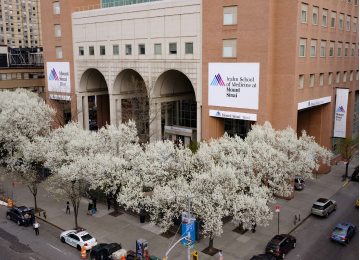
No, this is not some desperate cry for help or a Dear John letter from the grave to our readers. I am still very much alive. But on January 16th, it seemed my fate was sealed as I was laying on the shoreline of the River Styx. Ironically, it was not the years of damage I had done to my body that caused what was happening, but a genetic gift from the maternal side of my family that started it and proved to be the final nail in what would have been my coffin. Yet thanks to Dr. Nipa Gandhi and her team at Mount Sinai West (MSWest), my life was saved. And I could not be more thankful.
HOW IT ALL BEGAN
Let me start from the beginning so you understand the whole picture. This is where the genetic side of the situation comes in. The maternal side of my family suffers from severe gastro-intestinal issues such as diverticulitis. This is an infection that results from a disease called diverticulosis. Essentially, the disease creates pockets in the intestinal tract which can become infected. Once that infection, or diverticulitis, takes hold, the level of pain that accompanies it is something I personally pray none of you ever have to endure. I watched my Nana suffer in agony from this many times throughout my life, and she was the toughest woman I had ever known. As a boy, I often referred to her as Wonder Woman; a sentiment and belief I held until her passing at the age of 91. But even the Amazonian Princess had her weakness and for my Nana, this pain was too much. To give you some context – about 1 in 50 people have diverticulosis, however rare it is that it turns into the infection. Unfortunately, it is becoming more common. This is due to our aging population across multiple generations such as Baby Boomers and GenX. And research shows that now our population is beginning to suffer from this at younger ages with some blaming chemicals in the food supply chain, others blaming rampant use of narcotics and abuse of alcohol. Nana was one of those rare cases. And I am one that is a result of both the rarity as well as it becoming more common. In other words, genetics played a primary role while that commonality and my own foolishness accelerated it.
On Christmas Eve last year, at the age of 48, I ended up in the emergency room with my first attack of diverticulitis, far younger than my Nana was when she first suffered its fury. As my wife Kylie was in Australia visiting her family for Christmas, the only support I had at home was our dog, Brioreo (Bri). For six hours, I was hooked up to three IV lines of antibiotics to try and bring down the infection. They foolishly discharged me too soon, providing me with ten days of oral antibiotics and pain medication. I should have been on those IV lines for at least 24 hours. I spent much of the next week cuddling with Bri and binge-watching TV shows. As the New Year approached, I began returning to my normal routine, though I still felt a little off. And the timing could not have been better, or at least I thought so at the time.
On January 3rd, we announced that I had taken over as Editor-in-Chief (EIC) and on January 12th, my friends at the greatest gossip column in the world, Page Six, published that I had taken on the role. That day and into the 13th, my inbox was filling up while text messages were coming in like crazy with congratulations. My mobile was ringing off the hook, as we used to say, as if it were my birthday. What I didn’t know was that those Sisters of Fate had other plans for me.
A HORRIFIC TWIST OF FATE
That night, around seven o’clock, with Kylie still in Australia, I suddenly found myself on the floor of my bathroom, writhing and screaming in agony. The diverticulitis had never gone away, and from the pain and overall morose feeling, I knew sepsis was starting to take hold. At some point I lost consciousness as I don’t remember, somehow, getting dressed and walking out of my building onto 16th Street. Once on First Avenue, the windchill’s freezing bite startled me back into cognizance just as my legs buckled. I fell to the ground as I no longer had the ability to stand. With no one on the street, and darkness fully set, I knew waiting for an ambulance to another hospital facility would spell certain doom; my intestines would have burst from the infection.
I had no choice but to, literally, drag my own body up the street back to the ER that had mistreated me just three weeks prior. I remember being amazed that there was not a soul outside. I remember the smell coming from the deli on the corner and hoping that would not be the last thing I experienced. At the time, while praying for mercy as I crawled through 16th street to the emergency room, all I wanted was to feel the smoke from one last Marlboro cigarette in my lungs. All I wanted was to enjoy the smell of that tobacco exhaling from my nose and mouth in case my worst fears came to fruition. Sadly, I couldn’t even muster the strength to do that because it would have meant giving up on my destination. I had to make a conscious choice; have a cigarette to satisfy my addiction and disappear into the annuls of time or use every ounce of energy to get to the hospital. Needless to say, the human instinct for survival kicked in and I soldiered on.
Once I managed to get to the ER, I quickly realized just how bad things were. After a bit of drama at the start with the staff, as I am sure, given how filthy I was from the street, they thought I was a homeless person seeking a quick morphine fix, I called a neighbor to come help, my dear friend Natella (a fellow New York native who grew up in Hell’s Kitchen). I knew I would not be able to communicate much longer as the pain set deeper and that I needed someone with me to advocate for me. I was also worried because, if the worst-case scenario ensued, she could manage helping Bri who was home alone, getting in touch with Kylie in Australia and my family. Thankfully this wasn’t the case.
A HELPING HAND
Natella helped reach out to my parents, my wife and my Aunt Marissa who was closest and came in from Long Island. I knew if anyone could control the situation it would be the woman who has acted as my big sister my entire life (she is only nine years my senior). Marissa also knew what I was suffering from as she was there when Nana experienced her worst scenario of diverticulitis, resulting in a burst colon and colostomy. Sadly, almost an identical situation to what was about to happen to me.
The ER had me hooked up on heavy IV antibiotics, gave me a cat scan and issued a seemingly endless stream of pain medication. After passing out a few times from the pain and infection, I was finally able to talk to my wife. I could hear the worry in her voice. But more importantly, also the strength of faith in her knowing that I was going to make it through what I was about to experience: something that I can only describe as taking a sharp right turn into oncoming rush hour traffic on the FDR.
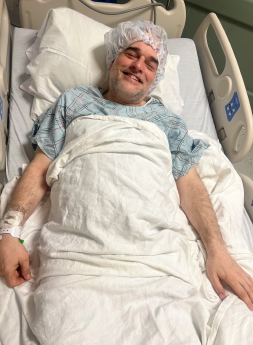
The ER needed to transfer me to Mount Sinai West immediately because of the severity of the infection. They had already alerted one of the best gastro surgeons in the city to my case, Dr. Nipa Gandhi who was en route to MS West. All I wanted to do was go home. But it was my aunt who made it clear to me that there was just no way that even my Irish American perseverance and pride would help me survive. Yes, the sepsis was that bad, and it was getting worse by the minute.
By seven o’clock on the morning of the 14th, I was in a room in the surgical wing of what used to be St. Luke’s-Roosevelt Hospital, had already had a second cat scan and bloods drawn. After a series of calls with the hospital, my parents and Marissa to make sure I was settled, Kylie was on a flight home that would take more than a day from Perth, Western Australia. My aunt had stayed with me all night to make sure I was okay and that I was getting the best possible care. Over the course of the next two weeks, she would check on me every day by phone, always ready to rush in if I asked for or needed her. That is who she has been my entire life.
MY SURGEON THE ANGEL
Then Dr. Gandhi walked into my room. My stomach was distended. My temperature on the roller coaster ride from hell. I didn’t want to have the surgery at all. Knowing that Kylie was on her way, and that the diverticulitis hadn’t perforated my intestines yet, they agreed to a 24-hour period of the heaviest IV antibiotics possible in the hopes of bringing the infection to bear.
I was in and out of consciousness over the next day, until Kylie arrived straight from the airport. Shortly thereafter, my stomach began to distend further with my temperature skyrocketing. Being the consummate caregiver, Kylie insisted the surgeon be informed right away. And when Dr. Gandhi marched into my room with her surgical team, that’s when reality really set in; there was nothing they could do but go in.
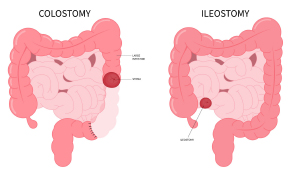
The sepsis was too severe. The latest scan and bloodwork had shown what they feared worst; the diverticulitis had eaten through the intestinal wall, pouring poison into my body cavity. But no one was prepared for just how bad things were about to get, except Dr. Gandhi.
They didn’t wait for transport to bring me down to the operating room. One of the surgical team stayed behind and prepped me in my room. He personally took me down. My wife kissed me and said, “I will see you soon” as we approached the surgical suite. I asked the doctor to stop the bed. I got up on my own two feet, grabbed the IV stand connected on wheels, and said, “If I am going to die, I am going to walk in on my own damn feet.” As I entered the operating room, Dr. Gandhi had the look of shock on her face, asking, “What are you doing?” I simply replied, “I’ll be damned if I’m going out like this. Like Frank, I’m doing it my way. Just tell me where you need me.” She had already discovered I was not a normal patient and that I was determined. So, she pointed to the operating table, and I plopped down right on it. As Dr. Gandhi diligently and kindly explained what was going to happen, the anesthesiologist still in shock that someone walked into the OR, explained the process to me for general anesthesia. As they put the mask on me, injected my IV port with medication to put me down, I remember seeing my Nana and Grandpa Jay standing there watching over me as if to say, “Fight. Fight like you’ve never fought before. You will live.”
DARKNESS FALLS
At first, Dr. Gandhi and her team used a laparoscope to see exactly what the damage was and what needed to be done so they could perform the surgery. As I was a heavy smoker of almost 40 years, the anesthesiologist voiced their concern that the surgery could not go more than five hours without complications. When the scope went in, the surgeon’s worst fear had come to pass; my entire body cavity filled up with dark puss, blocking their ability from being able to pre-assess.
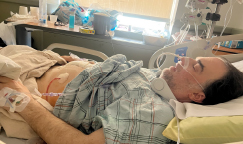
They immediately cut open my abdomen from above my belly button all the way down to my pubic bone. My body cavity was indeed full, with fungus growing on some of my organs. They had to remove most of my organs from the cavity, cleaning and inspecting each to make sure they were viable; perform an appendectomy, remove a section of my small bowel as well as parts of my intestines and give me an ileostomy. This is a surgical procedure that takes the end of the ileum (the lowest part of the small intestine) through an opening to form a stoma, usually on the lower right side of the abdomen, and into an apparatus that connects to a colostomy bag so you can expel waste. It bypasses the colon and is done so that the colon, small intestine and other parts of the waste extraction process has time to heal.
After almost six hours of surgery (yes, my lungs held on!), they put me into recovery and then brought me back to my room. When I woke up from the anesthesia the next day, I had a catheter, an oxygen tube in my nose, a waste drain in my nose for bile, a surgical drain in my abdomen, a colostomy bag, a massive incision closed with surgical staples and numerous IV lines out of my arm. I am not sure how much weight I lost at that time, but over the course of the more than two weeks I was in the hospital, I had dropped 40 pounds in fat and muscle mass. The problem here is that it also prevented me from having the strength to walk properly, or with any length. In other words, I was essentially crippled in a few ways.
However, there is no other way to say this than Dr. Gandhi literally saved my life that night. It is that simple.
OUT OF THE DARKNESS COMES THE LIGHT
The truth of the matter is that I literally felt less than human, less of a man. I had feared this is what I was going to live like for the rest of my life; a man who has to have a bag of waste attached to his stomach, emptying it into a toilet throughout the day. Someone strangers would look at and think, “freak.” Someone who at the age of 48 couldn’t get around without a walker or some semblance of physical assistance. Folks, as someone who has always been the emcee on stage before thousands, the guy on news shows before millions talking about any number of causes, or the man who was about to launch three podcasts, I felt my life was over. As it turns out, I could not have been more wrong.
Instead, what I found, was a renewed determination stemming from that Irish American perseverance, that pride, to beat the odds. Kylie and I feverishly scanned the internet, absorbing every ounce of information we could on ileostomy surgery, on recovery and what I needed to do to get my body back to normal. Despite knowing the odds, and what I had in front of me after suffering from such severe sepsis, I worked my proverbial ass off. I started to do leg and thigh exercises every day in bed; then began walking more and more in the apartment without a walker; finally extending that to being outside so as to make sure the loss of muscle mass I had suffered was not going to permanently cripple me.
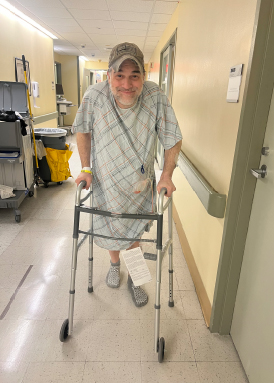
I became stubborn in following my surgeon’s instructions to the letter. I even ate all of the bland foods without cheating once (which is extremely difficult for a guy who has been cooking since he was five and loves to eat), took all of the medications, didn’t even think of having a cigarette and, most importantly, listen to everything my wife told me to do.
And in under six weeks, I have beaten those odds. The normal full recovery time for an ileostomy, from surgery to normalcy and the potential of a reversal, is three to four months. I achieved that in less than two. And, just so you know, a reversal is when they push the stoma back into your stomach, reconnecting it to the large intestine, and then seal up the hole in your gut where the stoma was. In other words, as of the writing of this story, roughly six weeks post-surgery, I have been cleared for reversal. Even the radiologist who took my last scans couldn’t believe it. He said, “I have never seen anything like this. Normally four months later we see a fully healed system.”
Well, I guess that perseverance, that stubbornness, and listening to my wife paid off. Especially that last part. Yes, Kylie was the most important part of my recovery. There was no guarantee that I would return to normalcy. There was no assurance that I would walk normally again. Yet, today, I am scheduled for that reversal and while I still have some physical weakness outside, every day is a better day. In other words, there is a tomorrow and I’ll be damned if I am going to let some addiction, or some sense of foolish nostalgia set me back. My time to rise from the ashes is here.
Check the June issue of New York Lifestyles Magazine for the next part in the story after Sean-Patrick has his reversal surgery
Why Apple
Health Works
How Apple Watch Series 10
Helps Me Recover
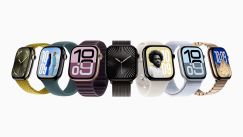
After teaching myself how to use a computer in the earliest days of DOS, I quickly became a technophile. It got to the point when I had to experience every new device, before or as soon as it was released. But, for whatever reason, during the pandemic, I lost my passion for it. So, when my medical crisis hit, one of the first thoughts I had was, “I need to start using tech to track my health progress so I can get through this faster.” But I was about three years behind in wearable technology. That’s when my friends at Apple gave me some advice.
I contacted a friend in Apple’s PR department shortly after being released from the hospital about helping me figure out what I needed to be able to track my health progress more effectively. Shortly thereafter, I started using their new Apple Watch Series 10 in tandem with the Apple Health app on my iPhone. Yes, I had used both before on earlier versions of the watch, but not to the degree I am now.
I can track all my exercise progress, weight management and diet, sleep routines as well as other vital readings to make sure I am progressing, but also to monitor for any shortcomings or warning signs. Plus, all the relevant information about my medical history is readily available to First Responders should I have any complications or emergencies. My Apple Watch Series 10 also alerts my emergency contacts in case of a fall or collapse which for me is a plus as I navigate getting strength back in my legs and lower extremities.
Finally, all the information from my Apple Watch and iPhone are tied into my MyChart account at Mount Sinai Hospital, which updates my medical care team so when I have checkups, all my relevant data is already there. That helps as they track my progress as well.
It takes a genius company like Apple to really understand the consumer need, especially with an aging population. Apple Watch Series 10 is not only a leap in wearable technology, it also gives me peace of mind to know that all of my information is literally at the tip of my fingers, or that of an EMT just in case.
Over the next couple of months, I am going to update our readers on the progress I am making using Apple Health, inclusive of Apple Watch, iPhone and more. And, just to be clear, the magazine is not receiving compensation for this. I am doing this to make sure our readers understand the benefit of how Apple technology can improve your health, and your life.





